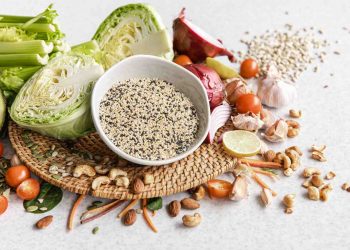Did you know that what you eat can significantly impact your eye health? It’s true! One of the standout players in the eye-health game is salmon. Packed with omega-3 fatty acids, antioxidants, and essential vitamins, salmon is not just delicious but also a powerhouse for maintaining good vision. So, grab your apron! Here are five mouthwatering salmon dishes that can help keep your peepers in tip-top shape.
Contents
1. Baked Lemon-Dill Salmon
Why It’s Great for Your Eyes
Lemon-dill salmon is not just a classic dish; it’s loaded with nutrients. Salmon is rich in omega-3 fatty acids, which have been shown to help reduce the risk of age-related macular degeneration (AMD) and dry eye syndrome. According to a study published in Ophthalmology, a diet high in omega-3s can lower the risk of developing AMD by up to 38% (Seddon et al., 2001).
Ingredients
- 4 salmon fillets
- 2 tablespoons olive oil
- Juice and zest of 1 lemon
- 2 tablespoons fresh dill, chopped
- Salt and pepper to taste
Instructions
- Preheat your oven to 375°F (190°C).
- Place the salmon fillets on a lined baking sheet.
- In a small bowl, mix olive oil, lemon juice, lemon zest, dill, salt, and pepper.
- Brush the mixture over the salmon.
- Bake for 15-20 minutes, or until the salmon flakes easily with a fork.
Pros and Cons
Pros: Quick, easy, and full of flavor. Perfect for a weeknight dinner!
Cons: If you’re not a fan of dill, you might want to substitute it with another herb like parsley or thyme.
2. Salmon Avocado Sushi Rolls
Why It’s Great for Your Eyes
Combining salmon with avocado not only makes for a tasty sushi roll but also boosts your eye health. Avocado is rich in lutein and zeaxanthin, two antioxidants that help protect against harmful light and support overall eye health. A study published in the Journal of Nutrition highlights that these carotenoids can help reduce the risk of cataracts (Ma et al., 2016).
Ingredients
- 1 cup sushi rice
- 2 cups water
- 1 tablespoon rice vinegar
- 4 sheets of nori (seaweed)
- 1 ripe avocado, sliced
- 8 ounces fresh salmon, thinly sliced
- Soy sauce, for serving
Instructions
- Rinse the sushi rice under cold water until the water runs clear. Combine rice and water in a pot and bring to a boil.
- Reduce heat, cover, and simmer for 20 minutes. Remove from heat and let it sit for 10 minutes.
- Stir in rice vinegar and let it cool.
- Place a sheet of nori on a bamboo mat, spread a thin layer of rice on top, leaving a small border.
- Arrange salmon and avocado slices in a line across the center of the rice.
- Roll tightly and slice into pieces. Serve with soy sauce.
Pros and Cons
Pros: Fun to make and eat! Plus, it’s a fresh option for lunch or dinner.
Cons: Rolling sushi can be tricky at first, so it might take a couple of tries to get it right.
3. Salmon Quinoa Salad
Why It’s Great for Your Eyes
Quinoa is not only a complete protein but also a good source of fiber and various nutrients that support eye health. When combined with salmon, you get a dish that’s both filling and beneficial. The omega-3s in salmon, along with the antioxidants in quinoa, make this salad a winner for your eyes.
Ingredients
- 1 cup quinoa
- 2 cups water
- 1 pound cooked salmon, flaked
- 1 cup cherry tomatoes, halved
- 1 cucumber, diced
- 1/4 cup red onion, diced
- 1/4 cup olive oil
- 2 tablespoons lemon juice
- Salt and pepper to taste
Instructions
- Rinse quinoa under cold water. Combine with water in a pot and bring to a boil.
- Reduce heat, cover, and simmer for 15 minutes or until water is absorbed. Let it cool.
- In a large bowl, combine flaked salmon, cherry tomatoes, cucumber, red onion, cooked quinoa, olive oil, lemon juice, salt, and pepper.
- Toss until well combined and enjoy!
Pros and Cons
Pros: A hearty, nutritious meal that’s perfect for lunch or dinner. Plus, it keeps well for meal prep!
Cons: If you’re not fond of quinoa, you can substitute it with brown rice or farro.
4. Creamy Salmon Pasta
Why It’s Great for Your Eyes
Pasta might not be the first thing that comes to mind for eye health, but when you add salmon and spinach, you’re in business! Spinach is loaded with lutein and zeaxanthin, which are crucial for eye protection. A study from the American Journal of Clinical Nutrition suggests that regular consumption of leafy greens can help maintain visual function (Boeing et al., 2012).
Ingredients
- 8 ounces pasta (your choice)
- 1 tablespoon olive oil
- 2 garlic cloves, minced
- 1 cup heavy cream
- 1 cup fresh spinach
- 8 ounces cooked salmon, flaked
- Salt and pepper to taste
- Parmesan cheese, for serving
Instructions
- Cook pasta according to package instructions. Drain and set aside.
- In a large skillet, heat olive oil over medium heat. Add garlic and sauté until fragrant.
- Pour in the heavy cream, bringing it to a gentle simmer.
- Add spinach and flaked salmon, stirring until heated through. Season with salt and pepper.
- Toss the pasta in the sauce and serve with a sprinkle of Parmesan cheese.
Pros and Cons
Pros: Comfort food at its finest! Rich and creamy, this dish is sure to satisfy.
Cons: It can be a bit heavy, so it’s best enjoyed in moderation.
5. Salmon Tacos with Mango Salsa
Why It’s Great for Your Eyes
Tacos are the ultimate fun food, and when filled with salmon and topped with mango salsa, they become a health powerhouse. Mango is packed with vitamins A and C, both crucial for maintaining healthy vision. According to research published in Nutrients, vitamin A is essential for good eyesight (Kumar et al., 2019).
Ingredients
- 4 salmon fillets
- 1 tablespoon olive oil
- 1 teaspoon chili powder
- Salt and pepper to taste
- 8 corn tortillas
- 1 mango, diced
- 1/2 red onion, diced
- 1/4 cup cilantro, chopped
- Juice of 1 lime
Instructions
- Preheat your grill or stovetop grill pan.
- Rub salmon fillets with olive oil, chili powder, salt, and pepper.
- Grill the salmon for about 5-6 minutes on each side or until cooked through.
- In a bowl, combine mango, red onion, cilantro, and lime juice to make the salsa.
- Serve the grilled salmon in corn tortillas topped with mango salsa.
Pros and Cons
Pros: A fun, fresh meal that’s perfect for gatherings! Plus, it’s vibrant and colorful.
Cons: If you’re not keen on spicy foods, you might want to adjust the chili powder to your preference.
FAQs
1. How often should I eat salmon for eye health?
Experts generally recommend consuming fatty fish like salmon at least twice a week to reap the benefits of omega-3 fatty acids for eye health.
2. Can I use frozen salmon for these recipes?
Absolutely! Frozen salmon is just as nutritious as fresh. Just make sure to thaw it properly before cooking.
3. Are there any alternatives to salmon for eye health?
Yes! Other fatty fish like mackerel, sardines, and trout also provide similar eye health benefits due to their high omega-3 content.
4. What are the signs of omega-3 deficiency?
Common signs include dry eyes, blurred vision, and difficulty seeing at night. If you experience these symptoms, consider boosting your omega-3 intake through diet or supplements.
Conclusion
Salmon isn’t just a tasty addition to your meals; it’s a key player in maintaining your eye health. From baked lemon-dill salmon to vibrant salmon tacos, these dishes offer both flavor and nutritional benefits. So, why not incorporate more salmon into your diet? Your eyes will thank you!
Remember, while these dishes are beneficial, always consult with a healthcare provider before making significant changes to your diet.
Disclaimer: This article is for educational purposes only and is not a substitute for professional medical advice. Always consult a qualified healthcare provider before making changes to your health routine.
References
-
Seddon, J. M., Ajani, U. A., Sperduto, R. D., et al. (2001). Dietary carotenoids, vitamins A, C, and E, and advanced age-related macular degeneration. Ophthalmology, 108(8), 1467-1475. https://doi.org/10.1016/S0161-6420(01)00519-2
-
Ma, L., et al. (2016). Dietary lutein and zeaxanthin and the risk of age-related cataract: a systematic review and meta-analysis. Journal of Nutrition, 146(1), 14-21. https://doi.org/10.3945/jn.115.219062
-
Boeing, H., et al. (2012). Critical review: fruits and vegetables and prevention of chronic diseases. American Journal of Clinical Nutrition, 96(5), 1162-1167. https://doi.org/10.3945/ajcn.112.037526
-
Kumar, V., et al. (2019). Vitamin A and eye health: A review. Nutrients, 11(4), 849. https://doi.org/10.3390/nu11040849
Get Your FREE Natural Health Guide!
Subscribe now and receive our exclusive ebook packed with natural health tips, practical wellness advice, and easy lifestyle changes — delivered straight to your inbox.














